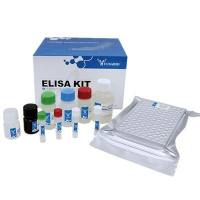Radioligand Binding Assays for the Glycine Site on N‐Methyl‐D‐Aspartate Receptors
互联网
- Abstract
- Table of Contents
- Materials
- Figures
- Literature Cited
Abstract
This unit describes a competitive binding assay for the glycine binding site on the NMDA subtype of glutamate receptors in rat brain homogenates. Agonists of the NMDA receptor associated glycine binding site have been proposed as potential therapeutics in cognitive disorders. Conversely, antagonists may be useful in a variety of disorders associated with excessive activation of EAA receptors, including Parkinsons, Huntingtons and Alzheimers Diseases, and neuropathic pain, among others. This unit describes a competitive binding assay for the glycine binding site on the NMDA subtype of glutamate receptors in rat
Table of Contents
- Basic Protocol 1: Measurement of Radioligand Binding to the Glycine Site on the NMDA Receptor
- Commentary
- Figures
- Tables
Materials
Basic Protocol 1: Measurement of Radioligand Binding to the Glycine Site on the NMDA Receptor
Materials
|
Figures
-
Figure 1.27.1 Competition for sites labeled by [3 H]MDL‐105,519. Typical curves for competitors (agonist and antagonist) for the glycine site on the NMDA ion channel using [3 H]MDL‐105,519 as the radioligand. Abbreviations: 5,7‐DCKA, 5,7‐dichlorokynurenic acid; HA966, R‐(+)‐3‐amino‐1‐hydroxy‐2‐pyrrolidinone. All compounds mentioned here are available from Sigma. View Image -
Figure 1.27.2 A representive curve of competition by glycine for sites labeled with [3 H]glycine. K i values for other reference compounds in competition with [3 H]glycine are shown in Table . View Image
Videos
Literature Cited
| Literature Cited | |
| Baron, B.M., Harrison, B.L., Kehne, J.H., Schmidt, C.J., van Giersbergen, P.L., White, H.S., Siegel, B.W., Senyah, Y., McCloskey, T.C., Fadayel, G.M., Taylor, V.L., Murawsky, M.K., Nyce, P., and Salituro, F.G.. 1997. Pharmacological characterization of MDL‐105,519, an NMDA receptor glycine site antagonist. Eur. J. Pharmacol. 323:181‐192. | |
| Bisaga, A., Popik, P., Bespalov, A.Y., and Danysz, W. 2000. Therapeutic potential of NMDA receptor antagonists in the treatment of alcohol and substance use disorders. Expert Opin. Investig. Drugs. 9:2233‐2248. | |
| Cheng, Y. and Prusoff, W.H. 1973. Relationship between the inhibition constant (K1) and the concentration of inhibitor which causes 50 per cent inhibition (I50) of an enzymatic reaction. Biochem. Pharmacol. 22:3099‐3108. | |
| Conn, P.J. and Pin, J.‐P. 1997. Pharmacology and functions of metabotropic glutamate receptors. Ann. Rev. Pharmacol. Toxicol. 37:205‐237. | |
| Evans, R.H. and Watkins, J.C. 1981. Pharmacological antagonists of excitant amino acid action. Life Sci. 28:1303‐1308. | |
| Fischer, G., Mutel, V., Trube, G., Malherbe, P., Kew, J.N., Mohacsi, E., Heitz, M.P., and Kemp, J.A. 1997. Ro 25‐6981, a highly potent and selective blocker of N‐methyl‐D‐aspartate receptors containing the NR2B subunit: Characterization in vitro. J. Pharmacol. Exp. Ther. 283:1285‐1292. | |
| Fisher, K., Coderre, T.J. and Hagen, N.A. 2000. Targeting the N‐methyl‐D‐aspartate receptor for chronic pain management. Preclinical animal studies, recent clinical experience and future research directions. J. Pain Symptom. Manage 20:358‐373. | |
| Grimwood, S., Richards, P., Murray, F., Harrison, N., Wingrove, P.B. and Hutson, P.H. 2000. Characterisation of N‐methyl‐D‐aspartate receptor‐specific [(3)H]Ifenprodil binding to recombinant human NR1a/NR2B receptors compared with native receptors in rodent brain membranes. J. Neurochem. 75:2455‐2463. | |
| Ivanovic, A., Reilander, H., Laube, B. and Kuhse, J. 1998. Expression and initial characterization of a soluble glycine binding domain of the N‐methyl‐D‐aspartate receptor NR1 subunit. J. Biol. Chem. 273:19933‐19937. | |
| Monahan, J.B., Corpus, V.M., Hood, W.F., Thomas, J.W. and Compton, R.P. 1989. Characterization of a [3H]‐glycine recognition site as a modulatory site of the NMDA receptor complex. J. Neurochem. 53:370‐375. | |
| Munoz, L.M., DeFeudis, F.V., and Fando, J.L. 1997. High‐affinity binding of glycine and beta‐alanine to synaptosome‐enriched fractions of rat CNS regions: Effects of strychnine. Gen. Pharmacol. 8:325‐330. | |
| Nakanishi, M. and Masu, M. 1994. Molecular diversity and functions of glutamate receptors. Ann. Rev. Biophys. Biomol. Struct. 23:319‐348. | |
| Petrie, R.X., Reid, I.C., and Stewart, C.A. 2000. The N‐methyl‐D‐aspartate receptor, synaptic plasticity, and depressive disorder: A critical review. Pharmacol. Ther. 87:11‐25. | |
| Ruiz‐Gomez, A., Garcia‐Calvo, M., Vazquez, J., Marvizon, J.C., Valdivieso, F. and Mayor, F. Jr. 1989. Thermodynamics of agonist and antagonist interaction with the strychnine‐sensitive glycine receptor. J. Neurochem. 52:1775‐1780. | |
| Siegel, B.W., Sreekrishna, K., and Baron, B.M., 1996. Binding of the radiolabeled glycine site antagonist [3H]MDL‐105,519 to homomeric NMDA‐NR1a receptors. Eur. J. Pharmacol. 312:357‐365. | |
| Snell, L.D., Morter, R.S., and Johnson, K.M. 1988. Structural requirements for activation of the glycine receptor that modulates the N‐methyl‐D‐aspartate operated channel. Eur. J. Pharmacol. 156:105‐110. | |
| Snyder, S.H. and Kim, P.M. 2000. D‐amino acids as putative neurotransmitters: Focus on D‐serine. Neurochem. Res. 25:553‐560. | |
| Young, A.B., and Snyder, S.H. 1974. Strychnine binding in rat spinal cord membranes associated with the synaptic glycine receptors: cooperativity of glycine interactions. Mol. Pharmacol. 10:790‐809. | |
| Key References | |
| Baron et al., 1997. See above. | |
| The primary article describing the characterization of [3H]MDL‐105,519 binding to the glycine site. | |
| Johnson, J.W. and Ascher, P. 1987. Glycine potentiates the NMDA response in cultured mouse brain neurons. Nature 325:529‐531. | |
| The original work demonstrating the specific interaction of glycine with the NMDA channel. |



![DKFZ-PSMA-11,4,6,12,19-Tetraazadocosane-1,3,7-tricarboxylic acid, 22-[3-[[[2-[[[5-(2-carboxyethyl)-2-hydroxyphenyl]methyl](carboxymethyl)amin](https://img1.dxycdn.com/p/s14/2025/1009/171/0405943971658126791.jpg!wh200)





